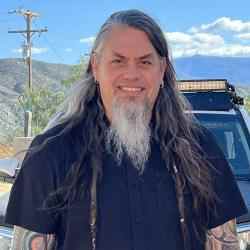Introduction
Gaël is encouraging communities to create "digital citizen security corps" to better anticipate and respond to crisis, with an initial focus on natural disasters. Beginning in Guadeloupe, where he successfully demonstrated what the effect of a digitally prepared citizen security corps would be, Gaël now spreads this idea in other French overseas territories; adapting his work, he is also working with citizen groups in the South of France to improve firefighting, and lobbying towards local public authorities to incorporate this digital citizen security corps in their emergency response plan.
The New Idea
Trained as a meteorologist and an electrical engineer, Gaël realized that the current top-down alert systems in France are not efficient enough to quickly and effectively inform the population when a catastrophe hits, thus increasing the number of victims; he also observed that they don’t give the citizens an active role in responding to crisis situations that put at risk their own security such as, in first place, natural disasters. Nevertheless, Gaël also observed that in most places highly competent “hackers”, meaning solution-oriented people who have the competencies to both design and run low-cost digital systems, can play an active and needed role in civil security. Once he has identified, mobilized and trained this local digital citizen security corps, Gaël engages all other citizens and local public authorities to relate to and work with this system, so that whether they represent a school, a hospital, a company or a family, they can act quickly and adequately before, during and after the emergency, and thus contribute to saving lives.
To equip the citizens with a better digital infrastructure that they would be able to manage in an efficient and coordinated way, Gaël leverages local communities of “makers”, “doers” and “hackers” to autonomously develop and improve low-cost open source crisis technologies, such as seismic sensors, and install them in identified high risk zones. In case of an alert, these sensors emit information directly onto social media networks, allowing the exposed populations to be informed in a few seconds and to respond. The mobilized citizen teams also include key people (like nurses, firemen, or political representatives) who can lead specific missions such as identifying shelter areas, supervising evacuations and undertaking related tasks such as mobilizing drones to spot people who have become isolated.
In addition, Gaël aims to infuse risk management culture among the institutional actors in order to streamline their traditional top-down information circuit in case of crisis situations such as natural disasters, but also other types of crisis like epidemics. Gaël is indeed already using the same insights to help the local health authorities spotting sources of proliferation of Dingue Fever in New Caledonia. Gaël works towards the appropriation of new technologies by the public authorities to best serve the security of all, and the recognition of the importance of the citizen role in improving crisis management. He also helps insurance companies to better assess their risk and increase their resilience as well as their clients’ one in times of crisis. Through numerous public / media interventions and the collection of data on the human and economic costs of disasters, Gaël advocates for prevention becoming the new norm.
The Problem
If countries regularly exposed to natural disasters, such as Chile, Venezuela or Japan, developed a very systemic approach to respond crisis, in most of the rest of the world, the alert systems needed have been much more flexible whereas there is a large amount of population concentrated in urban areas located near the ocean. Today, natural and human crisis situations are multiplying; in particular, global warming is causing a proliferation of natural disasters all over the world. Previously spared territories are now directly exposed, without the communities concerned being prepared for the risk. Reporting shows that 22 million people were displaced in 2013 due to natural disasters, compared with half less in 1970.
Managing a crisis requires taking decisions quickly with the only available information: this makes the speed to release information in time of crisis particularly key. Scientists estimate the average evacuation time of an unprepared population pool at 2 hours and 16 minutes, while a 20-meter wave occurs in only 39 minutes on average. A major challenge lies in the reduction and optimization of the time between the onset of the disaster and the moment at which the information is received by the populations. What is more, populations need to be well prepared to react quickly and adequately. A 2013 Swiss Re report shows that economic impacts 25 times higher in unprepared areas compared to areas that have developed this preventive culture.
But in France, the alert time is far from being optimized and the population is not enough trained to react: meteorological data is held by public authorities and there is no “risk culture”, thus leading to a crucial lack of preparation of both local representatives who are currently key in the alert process and the population. In addition, while they represent precious sources of information, the citizens are not integrated in the alert chain. New technologies are a formidable lever to fix this and improve the crisis management, but they keep being under-exploited as accelerating the alert process is not seen as a priority.
The Strategy
Through his organization, HAND (Hackers Against Natural Disasters), Gaël impulses local digital citizen security corps across territories that uses bottom-up technology to help citizens to alert, coordinate and organize themselves before, during and after a natural disaster.
Gaël’s methodology consists in developing local HAND chapters whose mission is to implement a local digital citizen security corps on a specific territory, for instance at a department level. To do so, Gaël first identifies local tech leaders (usually amongst digital fabrication labs’ users, the makers’ community, civic organizations…) who will constitute an open team to design and implement a local action plan whose characteristics should respect the HAND’s manifesto: every HAND local chapter’s action must be dedicated to improving natural disaster management and be citizen-led, independent, non-denominational, non-profit, collaborative and open source. With the objective to mobilize all the available useful competencies, the local teams are compounded not only by tech makers but also by other profiles such as nurses, firemen, local representatives, etc. Once the team is formed, Gaël supports the local team in analyzing the local context, identifying the local needs, and setting up a coherent annual action plan that includes mapping the area, developing and installing an alert infrastructure and training the local population, notably through massive simulation exercise.
To do so, Gaël leverages new technologies that gives the power to the citizens to act for their own safety before, during and just after the natural disaster. Before the disaster, the local technical leaders map the area with the help of drones to inform the population with the localization of zones of refuge. They also install the technical infrastructure that is necessary to convey the information directly to the citizens. In this sense, they conceive and deploy an open and citizen-owned alert system with low-cost resilient captors, such as seismic sensors and mareographs, as well as an autonomous telecommunication network (radio systems, 4G relay antenna, etc.). This allows the implementation of a bottom-up information circuit that transforms every citizen in a key player of the alert chain. During the disaster, the citizen community in close cooperation with the public authorities, leverages the social media to inform and indicate good practices. After the disaster, the citizen tech competencies should be mobilized to support rescue operations by collecting and sharing data, mapping zones, restoring the internet access or localizing people in remote areas.
Gaël first experimented this methodology in the French West Indies islands for two strategic reasons. First, these islands are highly exposed to the risks of natural disasters, but the inhabitants are manifestly unprepared. Second, they represent small and delimited areas that are ideal to experiment the installation of new digital infrastructures before targeting wider territories. Gaël reminds that the unpreparedness of the inhabitants clearly exacerbates the risk factor, and thus plans to target the territories deemed to be less exposed than the islands as a second step.
Thus, the first HAND local community was born in Guadeloupe in 2013 with first the strategic mobilization of local civic groups promoting open source practices, and managing a local citizen digital fabrication lab. Today, the local team has already mapped a 5,000 hectares’ zone, indicating exit procedures and identifying upper safe zones, install 34 km of Wi-Fi network over the sea to connect isolated islands, deployed several dozens of sensors directly connected to social networks and mobilized more than 10,000 people to contribute in institutional massive simulation exercises. Two more teams are already constituted in Martinique and Réunion islands to start implementing actions in 2017. Gaël also started to extend his successful methodology to continental areas: in the South of France, a local HAND chapter is building a digital infrastructure across citizens’ roofs to improve water bomber aircrafts tracking in collaboration with a consortium of 14 local public authorities and firefighting services.
To reach broader impact, influencing public authorities is also part of Gaël’s strategy to make them better consider risks and adopt more preventive approaches, and take the citizens’ role into consideration. To do so, not only Gaël hosts public talks to sensitize public authorities and rescue teams, but also effectively supports them in integrating new technologies, and the associated citizen role, in their institutional crisis management procedures. Gaël indeed works with every local HAND team towards creating collaborations with the local public authorities to combine expertise. For instance, in Martinique, a partnership is being built between HAND and the State crisis management cell. In addition, Gaël is also developing a statistical data base about natural disasters to keep raising authorities’ awareness on its human, economic and environmental consequences. Gaël also identified the insurance companies, who are directly concerned when a catastrophe hits, as key partners to engage to financially sustain his action while increasing his social impact. For now, he works with the biggest French insurance company to shift its investment priorities towards prevention, increase its resilience as an organization, and train their employees to better support the clients in times of crisis.
What is more, Gaël works towards transferring his hacking, solution-oriented and positive mindset towards disaster management to the next generation to transform the usual fear into a motivation to act. To do so, he leans on the HAND local chapters to organize in schools awareness sessions or entertaining workshops around developing simple precautionary tools, such as sensors to evaluate rising water levels.
The Person
Gaël grew up in Guadeloupe, French West Indies. Son of a minister, Gaël has been raised with a strict religious education and discovered the strength of belonging to a community; early, he has been taught the art of oratory and the importance of transmitting. Aged 8, Gaël already delivered speeches during religious ceremonies.
In 1989, at 9 years-old, Gaël faced the hurricane Hugo, which ravaged his house and his island. Deeply shocked, Gaël promised himself to become a meteorologist in order to avoid such a disaster to happen again. While growing up, Gaël became increasingly interested in science and IT: in 1993, he discovered free software on the computer of one of his father’s friends. From then on, Gaël developed an obsession to divert what surrounds him and creatively circumvent the rules by technology. His hacker abilities were very quickly brought to the service of others: for instance, he created solutions for helping his less talented classmates in science to do their homework.
Gaël moved to the French mainland to pursue technical studies and worked in parallel for a company which develops meteorogical sensors. Then, Gaël started to work as a technician for the Ministry of Ecology; realizing that he was missing cartography information to do his job properly, he dived into the Open Street Map community, a collaborative organization that gathers 3,000 citizens in order to create a free editable map of the world, in order to develop the cartography data himself. At that time, in parallel of his job, Gaël became actively engaged into the open source software communities and he realized the power of citizen-led open mapping while helping humanitarian organizations to map Haïti after the 2011 earthquake. Willing to structure an open mapping movement in France, Gaël co-founded Open Street Map France. Acting as president of the movement in France, Gaël demonstrated his capacity to mobilize and empower communities and to endorse the role of opinion leader in conferences he gave across the world in international institutions such as the UN and the World Bank.
Nevertheless, Gaël was not fully satisfied by the fact to always arrive “after” the disaster, like in Haïti, and started to imagine how the citizens’ technical competencies could be used in a more preventive approach. He came up with an open and citizen-led approach of disaster management, that would later on become HAND (Hackers Against Natural Disasters) – a project that is a perfect synthesis of what Gaël is consumed by: mobilizing solution-oriented communities, leveraging new technologies, and helping people to better face natural disasters.

 Tile image
Tile image


